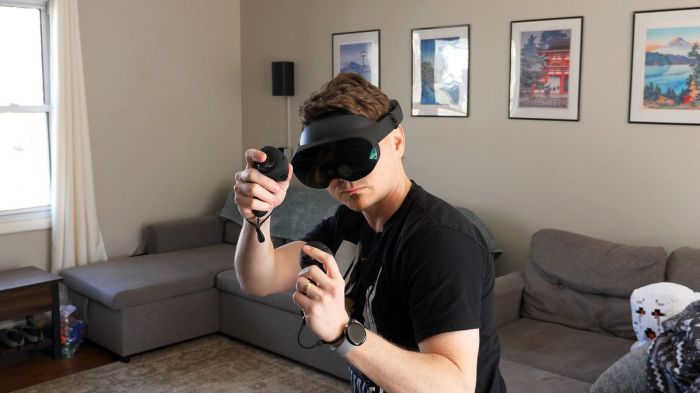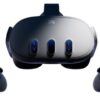Mixed reality on Quest 3 is exciting novelty but not its future. The buzz around Meta’s latest headset is undeniable, but is it more than a fleeting trend? This exploration delves into the current capabilities, the limitations, and the potential of mixed reality on the Quest 3, considering its current novelty and its path towards lasting value. Early adopters are clearly captivated, but can it sustain that excitement?
The Meta Quest 3, with its impressive specs and initial MR applications, promises a compelling experience. However, a critical examination reveals potential stumbling blocks. We’ll discuss the technical hurdles, the evolving user experience, and the need for a strong content ecosystem. Ultimately, we’ll consider if mixed reality on the Quest 3 is a promising innovation or just a shiny new toy.
Introduction to Mixed Reality on Quest 3

Mixed Reality (MR) blurs the lines between the physical and digital worlds, overlaying computer-generated images and sounds onto the user’s real-world environment. This creates immersive experiences that combine the best aspects of virtual reality (VR) and augmented reality (AR). The result is a richer, more interactive experience than either technology can offer alone.The Meta Quest 3, a powerful standalone VR headset, is making significant strides in MR.
Its high-resolution display, advanced tracking systems, and robust processing power are crucial elements for delivering compelling MR experiences. These capabilities, combined with the intuitive controllers and a robust software ecosystem, are setting the stage for a new wave of applications and innovations.
Current Mixed Reality Applications
Current MR applications are demonstrating the potential of this technology across various sectors. Examples include interactive museum exhibits where visitors can explore historical artifacts in a more engaging way, architectural walkthroughs that allow users to virtually walk through building designs before construction, and educational tools that offer hands-on learning experiences.
Meta Quest 3’s Mixed Reality Capabilities
The Meta Quest 3’s capabilities for MR are driving significant excitement. The headset’s high-resolution display, combined with advanced spatial tracking, enables a seamless integration of virtual objects into the user’s real-world environment. This enhanced precision and clarity of the MR experience allows for more intuitive and natural interactions with digital content.
Reasons for Excitement
The excitement surrounding MR on the Quest 3 stems from several key factors. First, the Quest 3’s powerful hardware provides the processing power needed for sophisticated MR experiences. Second, the intuitive controllers and user interface facilitate a natural and engaging interaction with virtual objects. Third, the growing ecosystem of MR applications and software development tools allows for innovation and creativity.
Comparison of VR/MR Device Capabilities
| Feature | Meta Quest 3 (MR) | HTC Vive Pro 2 (VR) | Microsoft HoloLens 2 (MR) |
|---|---|---|---|
| Display Resolution | High-resolution, suitable for MR | High-resolution, optimized for VR | High-resolution, optimized for MR |
| Spatial Tracking | Precise, accurate for MR overlays | Precise, but not always optimized for MR | Highly precise, optimized for MR |
| Processing Power | Powerful, capable of running complex MR apps | Powerful, capable of running complex VR apps | Powerful, but not as advanced as some PC-based MR solutions |
| Controller Interaction | Intuitive, designed for MR | Intuitive, but may not be as optimized for MR interactions | Specialized controllers, optimized for MR |
| Price | Competitive, affordable | More expensive | Expensive |
The Novelty Factor in Mixed Reality
Mixed Reality (MR) on the Quest 3 headset presents a captivating glimpse into the future of computing, promising seamless integration of the digital and physical worlds. However, the initial excitement around this technology needs to be carefully considered in the context of its potential for long-term adoption and widespread use. The novelty factor, while initially engaging, can mask the critical aspects of sustained value and practical application.The novelty of a technology often hinges on its initial appeal, sparking curiosity and enthusiasm.
Users are drawn to the novelty’s unique characteristics and the potential it represents, regardless of its practical usability. This initial excitement can quickly fade if the novelty is not followed up with compelling features, substantial improvement in user experience, or proven value.
The Transient Nature of Novelty
The appeal of novelty is often short-lived. A new technology might capture the public’s attention with its innovative design and futuristic concepts, but without demonstrable usefulness, it will fail to resonate beyond a specific timeframe. This is a common pattern in technological advancements. Many technologies initially hailed as revolutionary or game-changers have ultimately failed to achieve widespread adoption due to a lack of sustained value or market demand.
Mixed reality on the Quest 3 is definitely a cool new feature, but it’s not going to be the future of VR, I don’t think. While the tech is impressive, it’s crucial to be aware of potential privacy concerns, like how to scan for unknown trackers that might be following you. This guide provides some helpful tips.
Ultimately, while the novelty of mixed reality is undeniable, the true potential of VR likely lies elsewhere, perhaps in more advanced and refined applications beyond the current iteration.
Examples of Technologies that Didn’t Become Mainstream
Numerous technologies, once considered novel, have failed to become mainstream. The Segway, for instance, captured considerable media attention but struggled to find widespread adoption due to its practical limitations and high cost. Similarly, several virtual reality headsets from previous generations faced challenges in demonstrating consistent usability and compelling content, resulting in a limited user base. The “killer app” that would justify widespread adoption was often missing.
Factors Contributing to the Perception of MR as Novelty
Several factors contribute to the current perception of MR on Quest 3 as a novelty:
- The relatively new technology itself is still evolving, with ongoing improvements in hardware and software, and the development of sophisticated applications, potentially leading to a more useful user experience.
- The immersive experience offered by the Quest 3 is highly engaging, drawing users into virtual worlds with realistic visual and auditory feedback.
- The accessibility of the technology, allowing a broad range of users to experience the technology, is increasing its visibility.
- The novelty of the experience, coupled with the potential for applications in various sectors, creates anticipation for the future.
Novelty vs. Long-Term Value
| Aspect | Short-Term Appeal (Novelty) | Long-Term Value |
|---|---|---|
| Initial Impact | High excitement, curiosity, and buzz | Sustained usability, practical application, and widespread adoption |
| User Experience | Focus on unique features, immersive environments | Focus on practicality, efficiency, and ease of use |
| Market Adoption | Limited user base, niche applications | Widespread adoption across various industries and user groups |
| Cost-effectiveness | Potential for high initial investment | Cost-effective solutions, sustainable value proposition |
Potential Limitations of Current Mixed Reality: Mixed Reality On Quest 3 Is Exciting Novelty But Not Its Future
The Quest 3, with its mixed reality capabilities, presents exciting possibilities. However, inherent limitations in the current technology hinder its full potential. Understanding these constraints is crucial for realistic expectations and guiding future development. This exploration delves into the practical barriers, offering insights into processing power, software, user experience, content creation, and comparisons to previous VR generations.While the Quest 3 represents a significant leap forward in mixed reality, the technology is still relatively nascent.
Consequently, certain limitations are unavoidable, especially when considering the complexities of merging the virtual and physical worlds.
Processing Power Limitations
Current Quest 3 processing power, while improved, still faces limitations in complex mixed reality scenarios. The demands of rendering both virtual and real-world elements simultaneously can strain the hardware. This manifests in reduced frame rates, particularly in environments with numerous objects or dynamic interactions. For instance, a large, intricate virtual model overlaid on a real-world environment might experience stuttering or lag.
This limitation necessitates optimization in both software and hardware for a smooth user experience.
Software Limitations
The software ecosystem supporting mixed reality on the Quest 3 is still developing. A lack of sophisticated tools for developers restricts the creation of advanced and immersive experiences. Furthermore, the software’s stability and reliability can be affected by the inherent complexities of merging virtual and physical spaces. For example, some applications might experience unexpected glitches or errors during the interaction between the virtual and real worlds.
User Experience Limitations
The user experience in mixed reality is heavily influenced by the accuracy and responsiveness of the headset’s sensors and tracking mechanisms. Inaccurate tracking can result in a jarring experience as virtual elements fail to align correctly with the real world. Additionally, the design of the user interface needs further refinement for seamless navigation and interaction in this new hybrid space.
For example, the user might struggle to intuitively interact with both virtual and physical objects, hindering the overall experience.
Content Creation and Availability Limitations
Content creation for mixed reality experiences presents a challenge. The specialized tools and skills required for developing immersive, realistic mixed reality environments are still developing. Consequently, the availability of high-quality content is limited. Moreover, the cost of creating such content often exceeds the resources of many developers, thus limiting the overall variety and quantity of mixed reality experiences.
For example, the production of a detailed virtual museum exhibit that seamlessly integrates with a real-world space requires substantial effort and expertise.
Comparison to Previous VR Generations
Compared to previous VR generations, the Quest 3’s mixed reality capabilities are significantly more ambitious. However, limitations in processing power, software development, and content availability still remain. Early VR headsets often suffered from limited tracking accuracy, poor visuals, and restricted interactions. The Quest 3, while an advancement, still faces similar challenges in mixed reality due to the inherent complexity of merging the virtual and physical worlds.
For instance, the integration of physical and virtual elements in a dynamic real-time environment remains a significant hurdle.
Table of Key Limitations and Potential Solutions
| Limitation | Potential Solution |
|---|---|
| Processing Power Limitations | Hardware improvements, software optimization, and development of more efficient rendering algorithms. |
| Software Limitations | Development of more advanced software tools, improved software stability and debugging tools. |
| User Experience Limitations | More accurate and responsive tracking technology, improved user interface design, and more intuitive interaction methods. |
| Content Creation and Availability Limitations | Development of specialized content creation tools, increased investment in mixed reality content development, and promotion of community-driven content creation. |
The Future of Mixed Reality Beyond Novelty
Mixed Reality (MR) on the Quest 3 is undeniably exciting, showcasing a compelling novelty. However, its potential extends far beyond the current buzz. The technology, while still in its early stages, holds the promise of revolutionizing how we interact with the digital and physical worlds. This potential lies not just in the novelty of merging realities, but in its ability to fundamentally change industries and everyday life.The core of MR’s future lies in its capacity to transcend the current limitations of solely gaming or entertainment applications.
By exploring deeper integration with everyday tools and processes, MR can transition from a niche technology to a mainstream utility. This shift hinges on addressing usability challenges and developing more robust, intuitive interfaces.
Potential Applications Beyond Novelty
The initial applications of MR, like gaming and entertainment, are valuable stepping stones. However, the true transformative power of MR lies in its ability to permeate diverse sectors. The future holds the promise of more sophisticated and nuanced interactions between the physical and digital realms.
- Healthcare: Surgical training simulations, remote patient consultations, and personalized rehabilitation programs can benefit from MR. Imagine surgeons practicing complex procedures in a virtual operating room, or patients undergoing therapy with tailored MR-assisted exercises. These applications can improve efficiency and safety, leading to more effective medical outcomes.
- Education: Interactive learning experiences can be enhanced with MR. Students could explore historical events, dissect virtual anatomical models, or participate in immersive scientific experiments, thereby fostering a deeper understanding of complex concepts. This approach can cater to a wider range of learning styles and preferences.
- Architecture and Design: MR can offer revolutionary ways to visualize and interact with designs. Architects and engineers could virtually place furniture and decor in a room, or test the structural integrity of a building in a simulated environment. This method provides a tangible and interactive way to assess designs, potentially reducing errors and improving the design process.
- Manufacturing and Engineering: MR can aid in product design and assembly. Technicians could overlay digital instructions onto real-world objects, guiding them through assembly steps. This can reduce errors, improve efficiency, and enable better quality control in manufacturing environments.
Requirements for Mainstream Adoption
For MR to become a truly mainstream technology, several crucial factors must align. The user experience needs to be intuitive and seamless, and the technology needs to be readily available and affordable.
- Improved User Experience (UX): A crucial requirement for widespread adoption is a smooth, natural, and intuitive user interface. The ability to interact with MR overlays without significant cognitive load is essential for prolonged use.
- Cost Reduction: Currently, MR hardware and software are relatively expensive. Cost reduction is essential to make the technology accessible to a wider range of users and industries. This would require innovations in hardware design and software development.
- Enhanced Accessibility: Addressing accessibility concerns is crucial. MR systems need to be usable by people with disabilities, ensuring that the technology benefits everyone.
- Content Creation Infrastructure: Creating a robust ecosystem for content creation and distribution is vital. This means making it easier for developers to create and share MR experiences.
Current Status vs. Anticipated Future
Currently, MR is primarily focused on entertainment applications. The future, however, envisions MR seamlessly integrated into various aspects of daily life, from education to healthcare and beyond.
While mixed reality on the Quest 3 is undeniably a cool new feature, I’m not convinced it’s the future. The technology is exciting, but its current limitations feel a bit…early. Perhaps the real future lies in the evolution of wearable tech, like Apple’s AirPods Pro, which are now OTC hearing aids apple airpods pro otc hearing aids wearables headphones , blurring the lines between audio and health.
This innovative approach to personal technology could pave the way for a more integrated and seamless future, potentially overshadowing the mixed reality experiences on the Quest 3, at least for a while.
| Current Status | Predicted Future Advancements | Potential Impact |
|---|---|---|
| Limited applications, primarily in gaming and entertainment | Widespread adoption across diverse industries, including healthcare, education, manufacturing, and design | Enhanced efficiency, improved safety, and a more interactive learning environment |
| Relatively high cost and complexity of hardware and software | Significant cost reduction and improved hardware design leading to more affordable and accessible systems | Increased market penetration and broader adoption of MR technology |
| Limited user interface options | More intuitive and natural user interactions, reduced cognitive load | Improved user experience and higher engagement with MR applications |
| Limited content availability | Increased content creation and distribution infrastructure leading to a richer ecosystem of MR experiences | More diverse and innovative applications for a wider range of users and industries |
User Experience and Adoption

The Quest 3’s mixed reality (MR) capabilities represent a significant leap forward, but successful adoption hinges critically on the user experience. Understanding how users interact with and perceive MR technologies is paramount to unlocking their full potential. A positive user experience fosters engagement and encourages continued use, while a frustrating experience can lead to abandonment. This section delves into the nuances of user experience with MR on the Quest 3, examining factors influencing adoption, successful examples from related fields, and the obstacles that must be overcome.User experience with mixed reality on the Quest 3 is currently evolving.
Early adopters often experience a sense of wonder and novelty, exploring the potential of merging the digital and physical worlds. However, the practical application and seamless integration of these experiences remain a challenge. The effectiveness of MR applications depends heavily on factors like intuitive interfaces, responsiveness, and the perceived value of the experience. The quality of the user interface and the perceived utility of the application are key determinants in user engagement.
Factors Influencing User Adoption
Several factors influence the adoption of new technologies, including MR. Ease of use, perceived usefulness, social influence, and the availability of compelling applications all play a significant role. Early adopters are often driven by the novelty and excitement of new technologies, but widespread adoption requires the technology to be readily accessible and offer clear value propositions.
- Ease of Use: A user-friendly interface is crucial. Intuitive navigation, clear instructions, and minimal learning curve are vital for engaging users. The success of similar technologies like augmented reality (AR) games or navigation apps highlights the importance of seamless integration.
- Perceived Usefulness: Users must see tangible benefits from using MR. Applications must address real-world needs and offer solutions or enhancements not readily available in the physical world. For example, educational tools that enhance learning or design tools that improve workflow are more likely to be adopted.
- Social Influence: Word-of-mouth recommendations and social validation can significantly impact adoption rates. Positive reviews and demonstrations from trusted sources can create a snowball effect, increasing user interest.
- Availability of Compelling Applications: A diverse range of engaging and valuable applications is crucial for sustained interest. This includes applications that are useful, fun, and meet a variety of user needs.
Successful User Experiences with Similar Technologies
Successful adoption of similar technologies, such as AR mobile games and AR navigation apps, offers valuable insights. The widespread use of AR games, for instance, demonstrates the potential for engaging experiences to drive user adoption.
- AR Mobile Games: Games like Pokémon Go leveraged AR to create interactive experiences that seamlessly blended the digital and physical worlds. The games’ success highlights the appeal of novel, engaging, and social experiences.
- AR Navigation Apps: These apps offer augmented information overlaying the real world, providing guidance and directions. Their adoption demonstrates the practical utility of AR in everyday tasks.
Challenges in User Experience and Adoption
Several challenges hinder widespread MR adoption. One key challenge is the high cost of VR/MR headsets and associated software.
- High Cost of Equipment: The cost of VR/MR headsets can be a significant barrier to entry, limiting access to a broader user base. This is a crucial factor in ensuring that the technology is affordable and accessible to a wider range of users.
- Technical Limitations: Current MR technology sometimes faces limitations in terms of tracking accuracy, rendering speed, and overall system stability. Improving these technical aspects is essential for delivering a consistent and reliable user experience.
- Lack of Engaging Content: A lack of compelling applications and content can limit user engagement and adoption. Developing diverse and innovative applications is crucial to demonstrating the value of MR.
Role of User Feedback in Shaping Future Development
User feedback is essential for shaping the future of MR technology. Gathering feedback through surveys, reviews, and direct interaction with users helps identify areas for improvement and ensure that the technology evolves to meet real user needs.
- Continuous Feedback Loops: Developing continuous feedback mechanisms allows developers to incorporate user suggestions into the design process, leading to iterative improvements and more user-friendly experiences.
- Active User Engagement: Actively engaging users in the development process can foster a sense of ownership and encourage participation in shaping the future of the technology.
How User Experience Influences Long-Term Success
Positive user experiences are critical for the long-term success of MR. A positive experience fosters a sense of engagement and motivates users to explore and utilize the technology further. This ultimately contributes to the widespread adoption and integration of MR into various aspects of daily life.
Mixed reality on the Quest 3 is a genuinely cool new thing, but it’s just a flash in the pan. The underlying tech is promising, but the future of VR/AR likely lies beyond the current generation of headsets. Meanwhile, the complexities of web3, like the recent controversies around Coinbase, Apple’s moderation policies, and NFTs, are highlighting the messy realities of the digital world.
web3 coinbase apple moderation nfts show how far we still have to go in building a truly trustworthy and sustainable digital ecosystem. Ultimately, the future of mixed reality on headsets like the Quest 3 might depend on these broader developments, and that makes the whole concept a bit less exciting than the initial hype.
| User Experience Category | Description | Example |
|---|---|---|
| Positive | Intuitive, engaging, valuable, and enjoyable experience. | A user easily navigates a virtual museum and learns new information. |
| Neutral | Satisfactory but not exceptionally engaging or useful. | A user completes a basic task in a virtual environment but finds the experience somewhat bland. |
| Negative | Frustrating, confusing, or unengaging experience. | A user experiences frequent system glitches and errors during a virtual task. |
Content Creation and Availability
Mixed reality (MR) on the Quest 3 is a powerful platform, but its potential hinges significantly on the availability and quality of content. Creating compelling MR experiences requires a unique blend of technical skill and artistic vision. This section delves into the process, tools, and the current landscape of MR content, ultimately examining its impact on the broader adoption of this technology.The creation of MR experiences is not simply about slapping virtual objects into a real-world environment.
It necessitates a nuanced understanding of user interaction, spatial awareness, and the seamless integration of virtual and physical elements. This meticulous approach ensures that the MR experience is both engaging and intuitive for the user.
Content Creation Process
The creation of compelling MR content involves a multi-faceted process, often requiring collaboration between developers, designers, and artists. This process typically starts with a clear understanding of the desired experience, followed by conceptualization, design, development, and finally, testing and refinement. Prototyping and user feedback play a crucial role in ensuring the experience meets the needs and expectations of the target audience.
Tools and Platforms for Content Creation
Several tools and platforms facilitate the creation of MR experiences. Unity and Unreal Engine, popular game engines, offer robust frameworks for building MR applications. These engines provide a set of tools for creating 3D models, programming logic, and integrating various sensory elements within the MR environment. Specialized MR development kits and SDKs (software development kits) from Meta, like the one available for the Quest 3, further streamline the development process.
Examples of Compelling MR Content
A compelling example of MR content includes educational applications. Imagine a virtual anatomy model allowing students to explore the human body in intricate detail within their own classroom. Interactive museum tours can provide a richer, more immersive experience, allowing visitors to interact with historical artifacts in a new way. Entertainment applications such as interactive games and storytelling experiences also represent potential applications of MR.
Availability of High-Quality MR Content
Currently, the availability of high-quality MR content is still relatively limited. The initial excitement surrounding the technology has yet to translate into a significant volume of engaging experiences. However, the potential for innovative applications is vast, and developers are continually working to improve the quality and variety of content. This will likely increase as the technology matures and the developer community grows.
Impact of Content Creation on MR Adoption
The quality and availability of content directly influence the adoption rate of MR. Compelling and diverse experiences are crucial for convincing users of the value proposition of MR. When users have access to a wide range of engaging and practical applications, they are more likely to adopt and integrate MR into their daily lives. The availability of high-quality content is crucial to the widespread adoption of the technology.
Necessary Steps in Developing and Distributing Compelling MR Content, Mixed reality on quest 3 is exciting novelty but not its future
| Step | Description |
|---|---|
| 1. Ideation and Concept Development | Clearly define the MR experience’s purpose, target audience, and core functionalities. |
| 2. Design and Prototyping | Create interactive prototypes to test the user experience and refine the design. |
| 3. Development and Implementation | Develop the MR application using suitable tools and technologies. |
| 4. Testing and Refinement | Thoroughly test the application across various devices and user scenarios. Gather user feedback to iterate and improve. |
| 5. Content Optimization | Optimize the content for performance, stability, and accessibility. |
| 6. Distribution and Marketing | Select appropriate distribution channels, such as app stores, to reach the target audience. Develop marketing strategies to promote the application. |
Comparison with Other VR/AR Technologies
Mixed reality (MR) on the Quest 3, while a compelling new frontier, isn’t an isolated phenomenon. It sits within a broader landscape of virtual and augmented reality technologies, each with its own strengths and weaknesses. Understanding these comparisons is key to appreciating MR’s unique position and potential.Understanding the strengths and weaknesses of various VR/AR technologies is crucial for predicting their evolution and the potential for synergy.
Strengths and Weaknesses of VR, AR, and MR
The distinctions between VR, AR, and MR often blur in practice, but fundamental differences exist. VR immerses users completely in a virtual environment, while AR overlays digital information onto the real world. MR attempts to seamlessly blend these two, creating a hybrid experience. This blending allows for a greater degree of interaction with both virtual and physical environments.
The table below provides a concise overview of their strengths and weaknesses:
| Technology | Strengths | Weaknesses |
|---|---|---|
| Virtual Reality (VR) | Complete immersion in virtual worlds, highly engaging experiences, potential for interactive simulations and training. | Potential for motion sickness, social isolation, limited real-world interaction, cost of high-end hardware, and potentially lower accessibility. |
| Augmented Reality (AR) | Enhanced real-world experiences, overlays digital information seamlessly, practical applications in gaming, education, and professional fields. | Limited immersion compared to VR, potential for distraction if not well-designed, and sometimes reliance on specific markers or calibration, making the experience less portable. |
| Mixed Reality (MR) | Combines virtual and real worlds, enabling intuitive interaction with both, potential for creating immersive, interactive experiences, more natural interaction with the real world. | Challenges in seamlessly blending virtual and real environments, computational power requirements, potential for user disorientation if not carefully designed, and the ongoing need for refined software and hardware. |
Potential for Synergy
VR, AR, and MR technologies aren’t mutually exclusive. They can complement each other. For instance, VR could be used to create immersive training simulations that then transition into AR for real-world application. MR could allow for a seamless integration of virtual assets into real-world spaces, which could then be further enhanced by AR to provide additional context and information.
Examples of Complementary Technologies
A surgeon using VR for surgical training could transition to MR for practice on a patient simulator. This is one example of how VR and MR can collaborate. Alternatively, an architect might use AR to visualize designs in a real space, then use MR to further interact with the virtual model, placing it within the context of a real building site, and finally using VR to test the design in a completely virtual environment.
Evolution of the VR/AR Market
The VR/AR market is constantly evolving. Advancements in hardware, such as improved processing power and reduced latency in headsets, along with the development of more sophisticated software and user interfaces, will likely continue to drive the adoption of these technologies. The rise of cloud computing will also play a significant role in expanding accessibility and usability of these immersive experiences.
Final Thoughts
While the initial excitement around mixed reality on the Quest 3 is understandable, the future hinges on more than just novelty. The technology faces significant challenges in processing power, content creation, and user adoption. Overcoming these hurdles will be crucial for mixed reality to evolve beyond its current status as a compelling novelty and achieve mainstream acceptance. The journey to a mixed reality future on the Quest 3 is far from over.
This article hopes to give you a clearer perspective.






